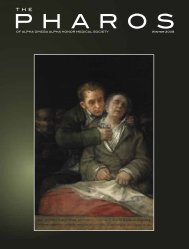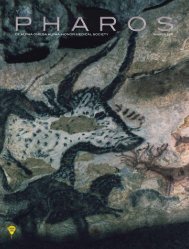The Pharos - Alpha Omega Alpha
The Pharos - Alpha Omega Alpha
The Pharos - Alpha Omega Alpha
You also want an ePaper? Increase the reach of your titles
YUMPU automatically turns print PDFs into web optimized ePapers that Google loves.
of work can be avoided, if we wish more surely and progressively<br />
to advance our manipulative therapy. 2<br />
Thus it may be said that the clinical training and emphasis on<br />
the concept of the physician-scientist that Cushing received<br />
during his four years with Halsted undoubtedly provided him<br />
with the skills necessary to pursue any surgical endeavor, and<br />
certainly contributed to the success of his chosen field of neurological<br />
surgery.<br />
Following approval from our institutional review board, and<br />
through the courtesy of the Alan Mason Chesney Archives, we<br />
reviewed the surgical cases from Cushing’s year as Halsted’s<br />
assistant surgical resident (1896–1897), as well as cases conducted<br />
during his time as Halsted’s senior surgical resident<br />
(1897–1900) and those conducted as a young attending specializing<br />
in neurosurgery (1901–1912). Except where otherwise<br />
indicated, quotations regarding these cases are taken verbatim<br />
from Cushing’s original unpublished surgical notes. <strong>The</strong>se files<br />
document the apprentice model of training proposed by Osler<br />
and Halsted, 5,6,7,10 and illustrate the role that general surgical<br />
experience played in Cushing’s development as a surgical<br />
trainee and physician-scientist.<br />
Only the lead surgeon was recorded consistently in the<br />
surgical record operative notes, with the first assistant or<br />
resident in attendance only sporadically documented. <strong>The</strong><br />
hospital records thus do not thoroughly document Cushing’s<br />
early presence in the operating room under Halsted’s supervision.<br />
<strong>The</strong> earliest record of Cushing as a participant is<br />
dated November 27, 1896.<br />
At this time, a twenty-twoyear-old<br />
woman presented<br />
with tuberculosis of the<br />
skin along her jaw. Cushing<br />
is listed as the surgeon of<br />
record, and the brief operative<br />
note describes the procedure,<br />
conducted under<br />
local cocaine anesthesia:<br />
lead surgeon, the operative note refers to Cushing by name.<br />
Although the majority of the roughly 1100 operative notes<br />
reviewed were written in the third person, Cushing typically<br />
omitted agency or referred to himself as “the operator.” This is<br />
the only note in which he refers to himself by name. Operative<br />
notes were not customarily typewritten before about 1900.<br />
Thus a comparison of handwritten notes initialed by Cushing<br />
with the operative note for this particular case shows that<br />
it was written by Cushing rather than Halsted. <strong>The</strong> unusual<br />
reference to himself as operator may reflect pride at being the<br />
lead surgeon for the first time, months of previous experience<br />
documenting operations conducted by other surgeons, or<br />
close supervision in this case by Halsted, both in the operating<br />
theater and in post-operative chart documentation.<br />
Cushing quickly progressed to more complex cases. On<br />
December 13, 1896, a sixteen-year-old woman employed in<br />
a shirt factory presented with “ingrowing toenails.” She was<br />
brought to the operating room on December 14, 1896, where<br />
Cushing excised the toenails. His hand-drawn illustration<br />
from the surgical chart and the detailed operative note document<br />
the procedure:<br />
A double cutting done on the left, the bad toe, nail not<br />
removed. A generous slice of tissue removed. On the right<br />
foot a simple excision of granulating area, removing ⅛˝ of<br />
the nail and matrix back to the neighborhood of the distal<br />
joint. Wound closed.<br />
<strong>The</strong> ulcerated area excised<br />
by Dr. Cushing. It<br />
was quite superficial apparently.<br />
Facial artery [. . .]<br />
tied c [illegible] during<br />
removal. Wound closed c<br />
interrupted silver suture.<br />
Cocaine.<br />
<strong>The</strong> patient was discharged<br />
on December 1, 1896; no further<br />
follow-up was available.<br />
It is interesting that here,<br />
in Cushing’s first case as the<br />
Cushing’s original illustration of an ingrown left toenail, his second operative procedure during his<br />
year as assistant surgical resident under Halsted.<br />
Courtesy of the Medical Records Office and the Alan Mason Chesney Medical Archives of Johns Hopkins Institutions.<br />
<strong>The</strong> <strong>Pharos</strong>/Autumn 2012 11














